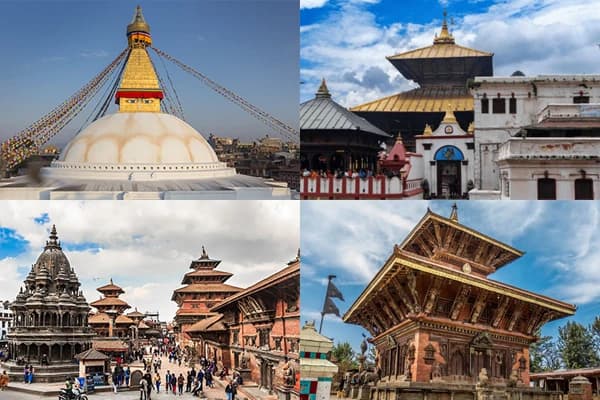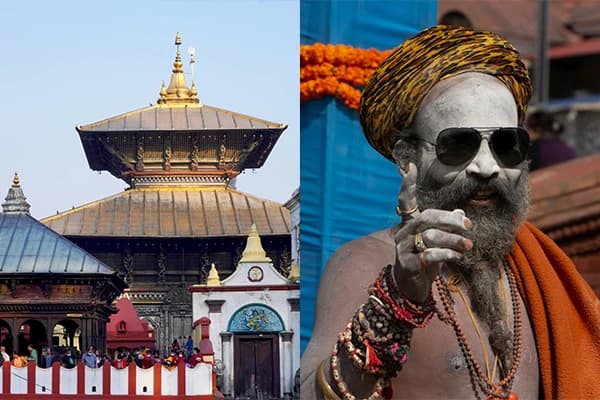Importance of Tihar Festival in Nepal in 2026
The Tihar festival in Nepal is deeply rooted in cultural, spiritual, and social dimensions. During the festival, the bonds between humans and animals are celebrated. The festival respects and honors the role that animals like crows, dogs, cows, and oxen play in the daily lives of humans and agriculture in Nepal.
The Tihar festival celebrations have spiritual significance also. On the third day, Goddess Laxmi (the goddess of wealth and prosperity) is worshipped. It is believed in Nepalese society that worshipping the Laxmi goddess brings wealth and prosperity to their homes. In addition, the crows and dogs are worshipped on the first and second days of the festival. The local believes that by doing so, the well-being of the deceased and the protection of the living from misfortune are ensured.
When the festival comes, the homes are decorated and lit along with flowers and rangolis. The Tihar lighting is done by traditional lamps as well as modern lighting. In addition, the Tihar festival becomes an important occasion for family reunions and gatherings. The rituals like tika ceremonies, gift exchanges, and blessings strengthen familial ties.
History of Tihar Festival in Nepal
Tihar history is deeply rooted in the Hindus’ mythology. According to Hindu mythology, the Yama (the god of death) and his sister, Yamuna, were not able to meet each other for a long time. So, in a deep desire to meet her brother, Yamuna sent messages through crows, dogs, and cows inviting him to visit her.
After getting the messages, Yama granted Yamuna’s wish by visiting her house. As a result, Yama blessed her with a boon that any brother who visits his sister on this day and accepts her hospitality will be protected from death. Since then, people celebrate the Tihar festival with joy and happiness. The main theme of Tihar Nepal 2026 is the reunion of siblings and strengthening their ties.
Five Days of Tihar 2026
The Tihar has its name called Yamapanchak, which is called the celebration of the union of the god Yama and his sister Yamuna. Each day is important and has its rituals and traditions. During the 5 days of Tihar, crows, dogs, cows, the goddess Laxmi, oxen, and the symbolic Govardhan hill are worshipped on different days.
-
Day 1: Kaag Tihar (Crow Festival)

Kaag Tihar is the first day of Tihar festival celebrations. This day is dedicated to honoring crows. There is a special importance of crows in Hindu mythology. According to Hindu mythology, the crow symbolizes the messenger of death and the link between the living world and the afterlife. It is believed that crows carry the souls of the departed to heaven. The crows are often linked with the Lord Yama, the god of death.
The rituals and customs associated with the Crow Festival include offering the foods to crows. Early in the morning, food items including sweets, fruits, nuts, and cooked rice are offered to the crows. These offerings are placed on the rooftops or the other elevated surfaces.
-
Day 2: Kukur Tihar (Dog Festival)

Kukur Tihar is the second day of the Tihar celebrations, in which kukur (dog) is honored and respected. According to Hindu mythology, dogs are said to guard the gates of the afterlife. Besides this story, dogs are considered guardians of households, and their presence is believed to protect families from evil spirits.
There are various rituals associated with these auspicious days. People garland their dogs, apply tika on their foreheads, and feed special foods to them. During this day, families gather to express their appreciation for the dogs. People who have pet dogs bathe them and worship them, while those who don’t have the dogs worship and feed the stray dogs.
-
Day 3: Gai Tihar and Laxmi Puja (Cow Festival and Worship of Goddess Laxmi)

The third day of Tihar is called Gai Tihar and Laxmi Puja. It is the day in which the cows are honored and the goddess Laxmi (the goddess of wealth and prosperity) is worshipped. In Hindu culture, cows are revered as symbols of motherhood, fertility, and benevolence. The milk of the cow is considered pure, and the cow dung and urine are used as fertilizer and fuel.
The third day of Tihar is called Gai Tihar and Laxmi Puja. It is the day in which the cows are honored and the goddess Laxmi (the goddess of wealth and prosperity) is worshipped. In Hindu culture, cows are revered as symbols of motherhood, fertility, and benevolence. The milk of the cow is considered pure, and the cow dung and urine are used as fertilizer and fuel.
As the day transitions from morning light to evening, the Laxmi Puja is started. The houses are cleaned and decorated with lights and diyas. Rangoli designs are created at the entrance of the home using colored powders, rice, and flower petals. Then,. A sacred altar is prepared in the prayer room where the idols of the goddess Laxmi, along with Lord Ganesha and other deities, are placed.
Then, families gather to perform puja for Laxmi, offering a variety of items, including jewelry and money, sweets, and fruits. In addition, special food items like sel roti (a sweet, deep-fried rice bread) are prepared and shared among family members.
-
Day 4: Govardhan Puja and Goru Puja (Oxen Festival and worship of Goverdhan Hill)

The fourth day of Tihar is called Govardhan Puja, or the Oxen Festival. There is the story in which Lord Krishna used Goverdhan Hill to protect the village of Vrindavan from the wrath of Indra (god of rainfall). Devotees create the symbolic representation of the Goverdhan Hill using the cow dung and then decorate it with colorful flowers and other embellishments.
The variety of food items (vegetarian items) are offered to the Lord Krishna, and prayers and aarti are performed. On the same day, the ox is also worshipped. The ox is bathed and adorned with garlands made of marigold flowers, and a sacred mark (tika) is applied to their foreheads. Then worship is done.
-
Day 5: Bhai Tika (Brother-Sister Day)

Bhai tika, also known as Tihar tika, is the fifth and last day of the Tihar festival.It is the day in which the sisters apply tika to their brother’s forehead. This ritual emphasizes love, respect, and protection within the sibling relationship. There are various rituals and celebrations associated with this day, including applying Tika, garlanding with Makhamali flowers, exchanging gifts, and feasting together.
At first, sisters worship their brothers with various rituals. And then, apply tika, which is made from seven different colors. Then, sisters adorn their brothers with garlands made from makhamali flowers. After the tika ceremony, brothers give gifts to their sisters. Then, families come together to share the prepared meals together.
Cultural practices and decorations during the Tihar festival 2026
The Tihar festival is full of unique cultural practices and decorations. One popular practice that is followed till date is the Deusi and Bhailo programs. In Deusi and Bhailo, groups of children and young adults visit homes singing traditional songs and dancing; in return, the people of the particular home give them gifts. During this event, people greet each other by saying "happy Tihar."
The card and dice games are also popular during the festival time. Families gather and play card games and dice games. This game adds festive spirit to the celebrations. However, according to the notice for Tihar 2082, playing card or dice games along with money investing is considered bad activity and is prohibited.
The Tihar is famous for the lights and decorations. During the festival time, the homes are illuminated with diyos (oil lamps), decorated with rangolis, and fireworks are used for celebrations. The Nepali tihar flower, like the marigold, is popular during the festival time. Also, symbolic decorations like garlands and tika are used for various rituals, enhancing the festive ambiance and symbolizing blessings from elders to younger family members.
Special Foods and Sweets of Tihar 2026
The special part about the Tihar festival is delicious sweets and savory treats. During the festival, a variety of food items are prepared and shared among family members. Some of the items include Barfi, Peda, Milk Peda, Lakhamari, Anarsa, Sel Roti, Phini Roti, Chini Roti, Dal, Bhat, Masu, Kadhi Badi, Besan ko Tarkari, and so on.
These food items are shared among the family members. The shared foods strengthen family bonds, foster unity and habits, and create rituals. The preparation of these food items needs collaboration and teamwork, which further enhances their bonds.
Tips for tourists visiting during Tihar 2026
- Engage in this traditional singing and dancing activity, Deusi and Bhailo.
- Combine your visit with kathmandu heritage tour and explore heritage sites.
- Do shopping in the Thamel marketplace.
- Be cautious about consuming street food.
- Respect animals and participate in animal worship responsibly.
- Be mindful of pedestrians while navigating busy streets during the festival.
- Consider joining organized photography tours that capture the essence of Tihar.
- Go for the trekking like everest base camp trek, annapurna base camp trek, manaslu circuit trek and so on to enjoy the festival celebrations in himalayan region.
To sum up..
The Tihar festival is the second largest festival that is celebrated all over Nepal. The festival honors animals like crows, dogs, cows, and oxen, symbolizing the victory of light over darkness. The best part about the Tihar festival is that it strengthens the bond between siblings, particularly on Bhai Tika, the final day.
One can notice the changes, like lights, rangolis, and flowers, when the festival days come nearer. The special food items are prepared and shared among family members. The Tihar festival becomes more special with the cultural activities like the Deusi and Bhailo programs. This festival truly reflects gratitude, spiritual significance, and the strengthening of familial and social ties.
This Tihar, let Nepal’s festivals warm your heart and its adventures thrill your soul. Remember us for your adventure in Nepal in 2026.










